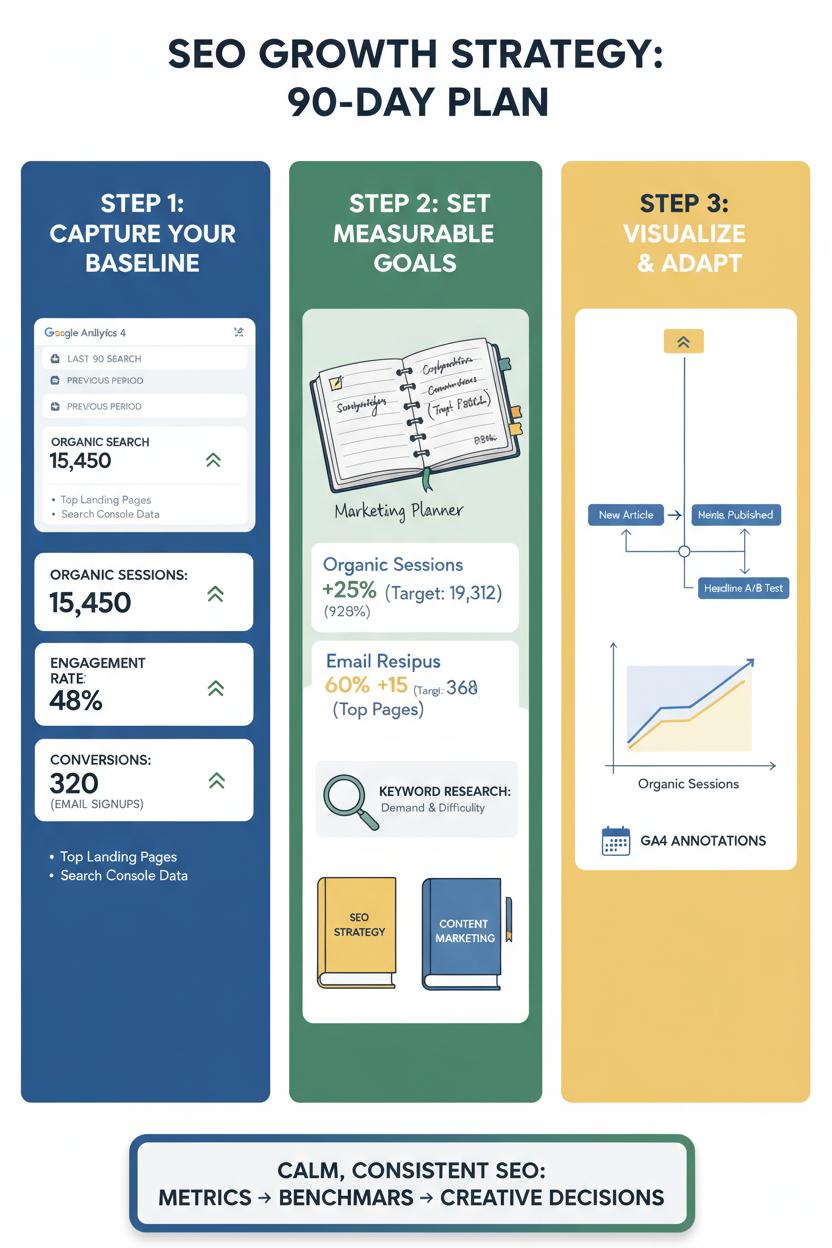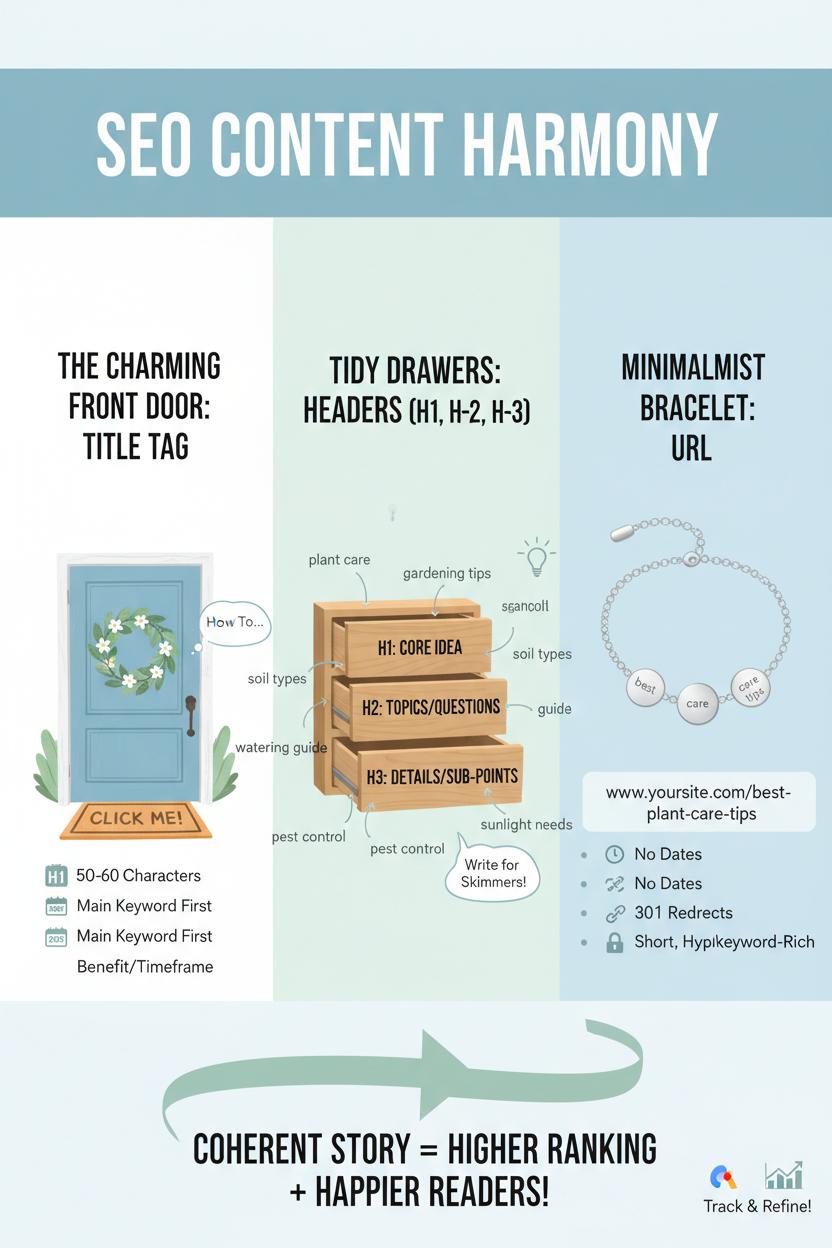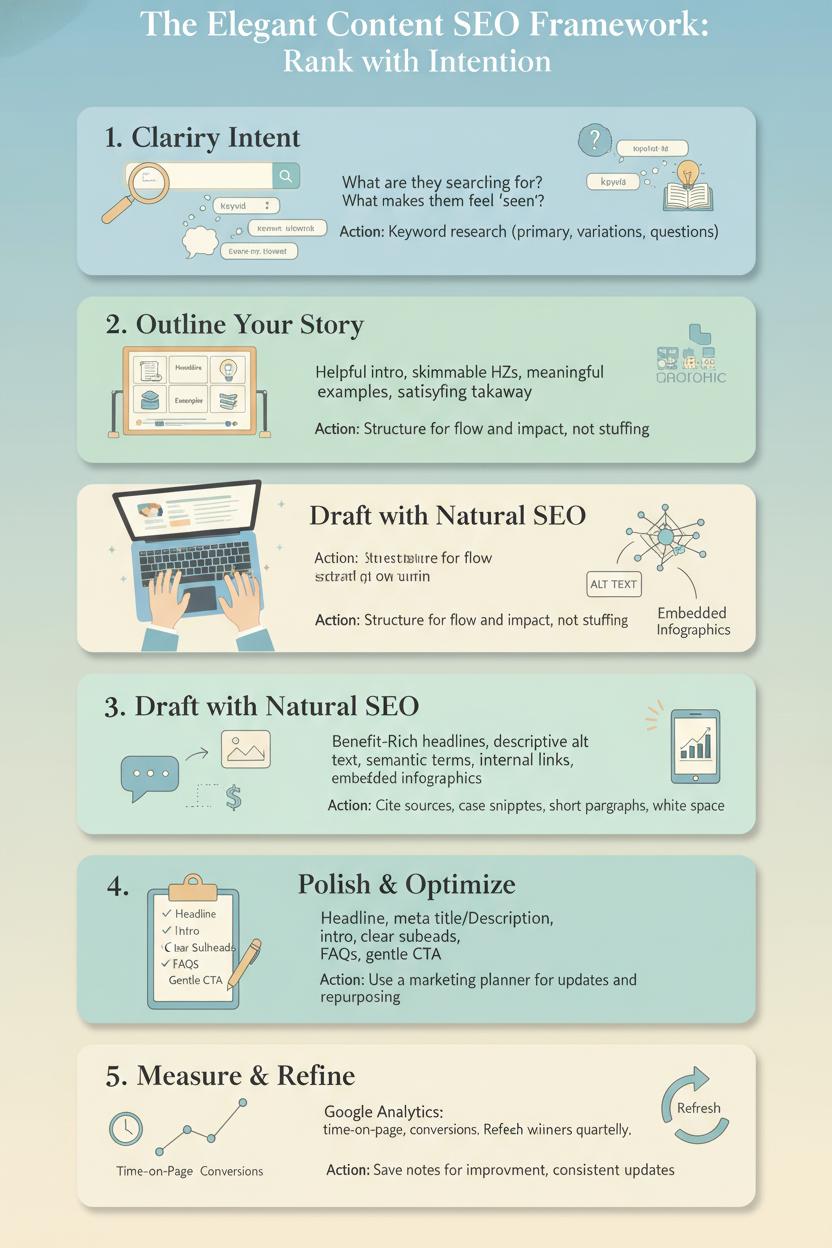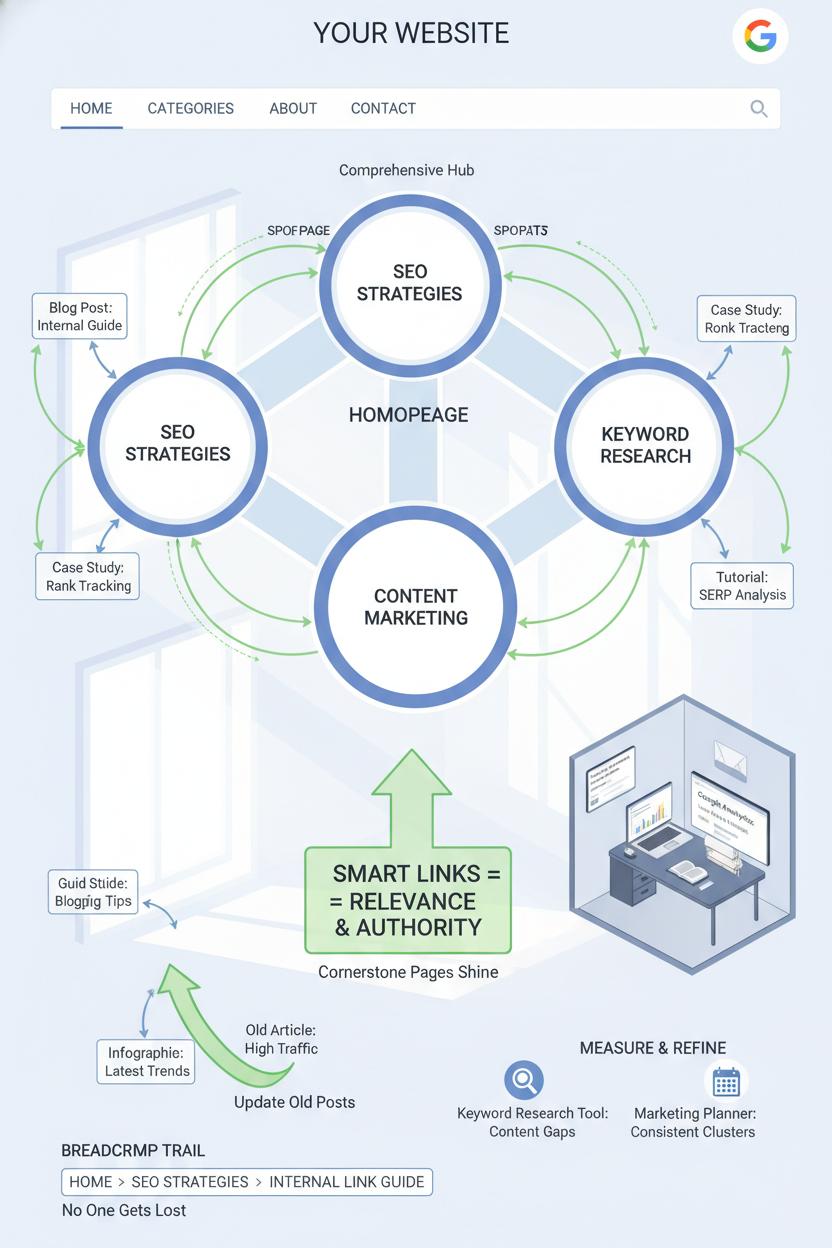Ready to rank on Google in 2025? This SEO infographic breaks down 9 actionable search engine optimization tips—from smarter keyword research to high-converting content SEO—that you can implement today. Pin now, read later, and watch your traffic grow. We’ll also share favorite tools and reads, from top-rated SEO books and a go-to keyword research tool to a concise Google Analytics guide, content marketing book, and even a marketing planner to keep you on track. Grab the steps, optimize your pages, and start climbing the SERPs.
Step 1: Define SEO goals and baselines with a Google Analytics guide

Pour a fresh coffee, clear a little space on your desk, and open your favorite Google Analytics guide—because Step 1 is all about setting intentions you can actually measure. Before you daydream about the traffic you want, capture the traffic you have. In GA4, set your date range to the last 90 days, add a comparison to the previous period, and filter by Organic Search in Default Channel Group. Note your current organic sessions, users, engaged sessions, engagement rate, conversions, and revenue if relevant. Peek at Landing Page performance to see which URLs pull in the most organic visitors and how they behave once they arrive. If you want to rank on Google for new terms, connect the Search Console integration so you can see queries, impressions, and CTR alongside those pages—your baseline story, all in one place. Consider this your before photo for the SEO infographic you’ll build through the rest of the steps.
Now translate the numbers into goals that feel doable and exciting. Choose one to three clear targets, like “Increase organic sessions by 25% in 90 days,” “Lift engagement rate on top landing pages to 60%,” or “Grow email signups from organic by 15%.” Write them in your marketing planner with today’s baselines beside each goal. Then layer in keyword research to align goals with search intent: which pages deserve a refresh, and which new topics could bring qualified visitors? A simple keyword research tool can show demand and difficulty, while a couple of well-thumbed SEO books or a content marketing book can help you turn data into content SEO that resonates. Prioritize pages that already perform decently; nudging them up often delivers the quickest wins.
Finally, make it visual so you stick with it. Create a simple SEO infographic-style dashboard you’ll actually check—color-code your goals, paste screenshots of your baseline, and jot down one sentence about what you’ll try next. Add annotations in GA4 when you publish a new article or update a headline, so cause and effect becomes visible over time. This is the calm, consistent foundation of search engine optimization tips that work: choose your metrics, set your benchmarks, and let every creative decision ladder back to the numbers.
Step 2: Master keyword research with the right keyword research tool

This is the part of your strategy where everything starts to click: keyword research is how you step into your audience’s shoes and find the exact phrases they’re typing at midnight with a cup of tea. If you’re skimming this SEO infographic and wondering how it all connects, think of the right keyword research tool as your compass. Start with a few “seed” topics you’d love to talk about, then branch into long-tail phrases that feel conversational and specific—those are often faster ways to rank on Google because they match real intent. Peek at the search results to sense the mood: Are people looking for quick answers, deep guides, or shopping pages? That intent should shape your outline before you write a single line.
Now, get cozy with the data. Compare search volume to difficulty, and don’t overlook questions, prepositions, and “near me” terms if they fit your niche. Save the gems in a simple spreadsheet or your favorite marketing planner, grouping them into clusters that can blossom into a content hub. That’s where content SEO shines—one pillar page supported by helpful, narrower posts gives Google a clear map of your expertise. Sprinkle in related keywords naturally (synonyms, variations, and problem-solution angles), and you’ll build a semantic web that feels human, not robotic. These are the quiet search engine optimization tips that add up: use your primary phrase in the title, first paragraph, and headers; write for readers first; and let image alt text, meta descriptions, and internal links do supporting work.
If you’re new to the process, a dependable keyword research tool plus a few well-chosen resources can speed everything up. Skim fresh SEO books or a content marketing book for strategy frameworks, then pair your findings with a Google Analytics guide to see which keywords actually convert. Keep a running list of seasonal terms and evergreen staples, and revisit it monthly to spot trends before they spike. The goal isn’t to chase every keyword—it’s to choose the ones that match your voice, your offer, and your audience’s next step. Do that consistently, and your posts will feel tailor-made—and steadily rank on Google without guesswork.
Step 3: Build a marketing planner to map content SEO topics and cadence

This is the cozy, color-coded heart of your strategy: open your marketing planner, pour a fresh coffee, and start mapping the topics and tempo that will keep your brand humming all year. Think of your calendar as a visual storyboard, much like the SEO infographic in this post—pillars down the left (your evergreen themes) and clusters fanning out beneath them (specific questions, how-tos, comparisons). For each pillar, brainstorm a handful of content SEO ideas that solve real problems, then layer in your promotional seasons, launches, and holidays. Warm up the page with color labels for blog posts, Reels, pins, and emails, and mark batch days so creation fits your life instead of hijacking it. When you glance at the month, you should see balance: one educational deep dive, one quick win, one community story, one data or trend piece.
Build your topics with keyword research, not guesswork. A favorite keyword research tool will help you spot search intent, difficulty, and gaps your competitors missed. Group similar phrases under one page to avoid cannibalization, then plan supportive posts that link together so Google understands your theme. This is content SEO in motion: a main guide, flanked by FAQs, checklists, and comparisons, all interlinked and pinned across platforms. Set cadence rules you can actually keep—maybe Tuesday tutorials, Thursday tips, and one monthly long-form guide. Use headings and notes in your planner to capture working titles, target keywords, internal links to add, and repurposing ideas (blog to pin to email to short video). If you like a tactile nudge, keep a couple of trusted SEO books or a dog-eared content marketing book nearby for frameworks and prompts when the page feels blank.
Finally, give your plan a feedback loop. Borrow a page from any solid Google Analytics guide: track which posts bring the most engaged sessions, saves, and sign-ups, then adjust your cadence to amplify what works. Sprinkle in fresh search engine optimization tips each month—better intros, clearer calls to action, faster images—to help every piece rank on Google a little higher. Your marketing planner isn’t a static document; it’s a living rhythm that keeps you consistent, creative, and ready to fill next month’s squares with ideas before they ever run dry.
Step 4: On-page search engine optimization tips for titles, headers, and URLs

Think of your title tag like the charming front door of your post—the color, the wreath, the welcome mat all rolled into one. Lead with your main keyword and your reader’s intent, then add a soft sparkle with a benefit or timeframe: “How to…” “Beginner’s Guide,” “2025.” Aim for 50–60 characters so it displays cleanly and tempts a click without feeling like clickbait. Use a natural voice, but make every word earn its spot. If you’re stuck, flip through your favorite SEO books or a content marketing book for headline frameworks, then jot variations in your marketing planner. Our SEO infographic reminds us that titles aren’t just labels; they’re tiny promises you must keep on the page.
Your headers are where clarity meets comfort. Keep just one H1 that mirrors the title’s core idea, then organize H2s and H3s like tidy drawers—each with a clear purpose. Weave in related phrases you discovered during keyword research, but write for skimmers: short, descriptive headers that answer the “What’s in this section?” question immediately. Add a question-based subhead or two to mirror how people search and support content SEO without stuffing. If you need inspiration, explore a keyword research tool to surface synonyms and long-tails you can tuck into subheads naturally. These structural choices help you rank on Google because they signal topical depth and make readers linger longer.
Now for URLs—the minimalist bracelet to your outfit. Keep them short, lowercase, and hyphenated, with one precise keyword and no filler words: think /best-plant-care-tips, not /the-ultimate-guide-to-the-very-best-plant-care-tips-ever. Avoid dates unless freshness is the point, and try not to change slugs once published (if you must, use a 301 redirect). Before you hit publish, sanity-check the pairing of title, H1, headers, and URL so they tell one coherent story. Track what wins by pairing your drafts with a Google Analytics guide, and let the data refine future headlines. Over time, these small, elegant choices compound—like curating a capsule wardrobe for your site—making every page easier to discover, easier to love, and easier to share from that pretty SEO infographic on your board.
Step 5: Create high-quality content SEO using insights from top SEO books and a content marketing book

This is the cozy, creative part of the process—where your ideas become bookmark-worthy posts that quietly work for you every day. Use the wisdom from your favorite SEO books and a trusted content marketing book to shape a content SEO approach that feels intentional, elegant, and effective. Start by clarifying search intent: What would someone type when they’re looking for this solution, and what would make them feel “seen” when they land on your page? Open your keyword research tool and gather a primary keyword plus a few supporting variations and questions. Then outline your piece like a story: a helpful intro, skimmable H2s, meaningful examples, and a satisfying takeaway. Think of this step like laying out a mood board—each element supports the overall vision to rank on Google without feeling stuffed or salesy.
As you draft, weave in search engine optimization tips naturally. Lead with a benefit-rich headline that promises an outcome, and use descriptive alt text for images. Sprinkle in semantically related terms so Google understands context, and add internal links to your cornerstone guides. If you have an SEO infographic, embed it to boost engagement and shares. Cite reputable sources, bring in a brief case snippet or firsthand observation, and format for flow: short paragraphs, generous white space, and warm, clear language. A simple checklist helps—headline, meta title and description, intro that mirrors search intent, clear subheads, FAQs, and a gentle call to action. Keep a marketing planner nearby to map updates and repurposing ideas so each post becomes a multi-platform asset.
Finally, measure and refine. Follow a beginner-friendly Google Analytics guide to watch which pieces win the most time-on-page and conversions, and refresh winners with new data, FAQs, or visuals every quarter. Save notes in your outline for what to improve next time: maybe a tighter hook, stronger examples, or a fresh angle you spotted while thumbing through new SEO books. Pair your insights with disciplined keyword research, reader-first formatting, and consistent updates, and your content SEO will compound—helping your brand rank on Google while feeling as polished and shareable as your favorite pin.
Step 8: Strengthen internal linking and site architecture for relevance and authority

Think of your website like a sunlit studio apartment: every room has a purpose, and the best pieces are displayed where guests can find them with ease. Internal links are your curated pathways, guiding both readers and crawlers through your most helpful work so you can rank on Google with less guesswork. In this step, give your site a graceful floor plan—clear navigation at the top, meaningful categories, and a gentle breadcrumb trail so no one feels lost. Use our SEO infographic as your visual reminder: smart links pass relevance and authority, helping your cornerstone pages shine. When your structure is tidy and intuitive, it supports all your content SEO efforts, turning casual scrollers into confident explorers who stay longer and engage more.
Start by clustering posts into “hub and spoke” themes. Choose one comprehensive hub page for each topic and link to it from your related articles, then link back out to those spokes. This is where keyword research becomes your compass: map terms to hubs, and use natural, descriptive anchor text that mirrors search intent without feeling stiff. Keep important pages within three clicks of the homepage, fix orphan pages by giving them at least two internal links, and sprinkle contextual “read next” suggestions at moments of high curiosity. Update older high-traffic posts to link to your latest guides—this is one of those simple search engine optimization tips that quietly compounds. A lightweight keyword research tool can help you spot content gaps, while a marketing planner keeps your clusters consistent across the season.
Measure what’s working and prune what isn’t. Use Search Console to find pages with strong impressions but low clicks, then add internal links to them from authority pages. Follow a Google Analytics guide to check user paths, time on page, and where people drop off; small link tweaks can revive underloved content. If you like a hands-on approach, skim a few SEO books or a content marketing book for architecture patterns you can adapt, and keep quick notes in your dashboard. Revisit this step quarterly, refreshing your links as new posts go live. Over time, your site will feel like a beautifully organized gallery—easy to browse, rich with discovery, and designed to help every visitor (and crawler) find exactly what they need.
Step 9: Track, test, and iterate—dashboards, reports, and KPI reviews

Pour a fresh cup and turn your dashboards into a cozy weekly ritual. Think of them like a visual mood board for your performance: traffic, rankings, conversions, and the tiny signals that whisper where to go next. Start with the essentials—organic sessions, click-through rate, average position, and conversions—then zoom into page-level details to see which posts actually help you rank on Google and which need a lift. Scan your Search Console for queries you almost own (positions 4–12), note Core Web Vitals, and peek at index coverage so technical snags don’t mute your momentum. Tie it all back to intent: does the page match the promise of the query? Use that question as a lighthouse for content SEO updates. Keep a Google Analytics guide within reach so your reports tell a story, not just a number. And yes, a few sticky notes or a tidy marketing planner can make KPI reviews feel less intimidating and more like a creative reset.
Now, test like a stylist refining an outfit. A/B your titles and meta descriptions to earn more clicks without changing rankings. Refresh intros, reframe H2s, and add schema to strengthen snippets. Re-run keyword research to catch rising terms, then use your favorite keyword research tool to validate opportunity size and difficulty before you rewrite. Track each experiment—what you changed, when, and why—so your monthly KPI review reads like a narrative of cause and effect. If you love deep dives, keep a couple of dog-eared SEO books or a go-to content marketing book on your desk for frameworks that sharpen your approach. The goal isn’t perfection; it’s steady iteration: adjust internal links, prune thin pages, expand sections that win engagement, and celebrate the posts that carry your brand voice beautifully. Keep this SEO infographic handy as your checklist, layering in new search engine optimization tips as you learn. When dashboards become a habit and reports become a conversation, every quarter you’ll look back and see a feed of small, thoughtful changes stacking into big results.
Conclusion
Pin this SEO infographic as your go-to roadmap. With smart keyword research, clean tech basics, and consistent content SEO, you’re ready to rank on Google without the overwhelm. Save these search engine optimization tips, brew a cozy cup, and tackle one step at a time: optimize pages, refresh old posts, earn trustworthy links, and measure what matters. Small, steady tweaks add up to big visibility. So exhale, choose your next task, and let your 2025 strategy shine. Your best traffic story starts here.